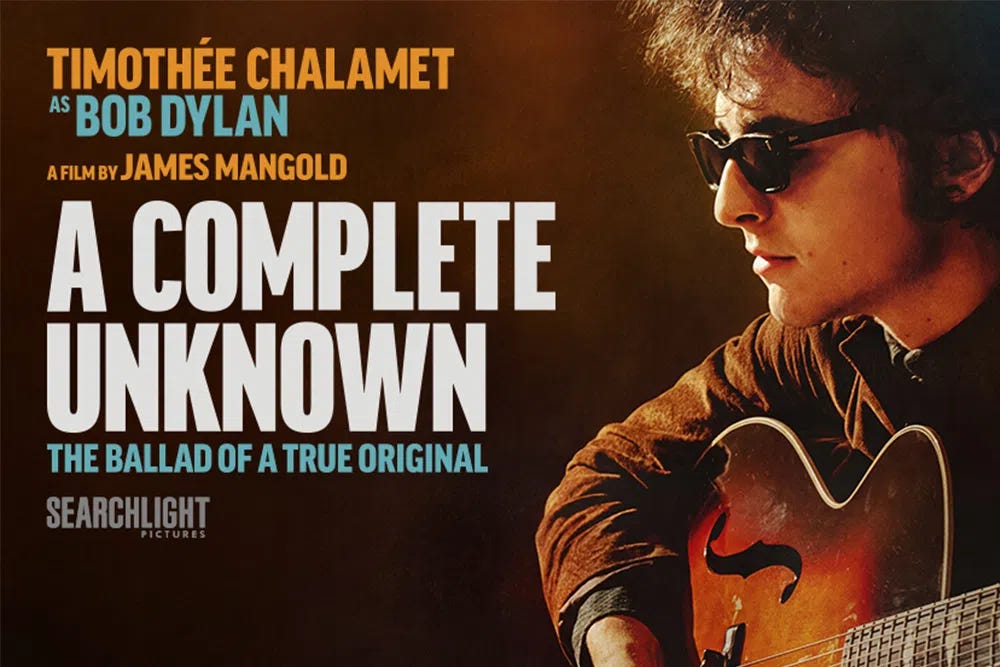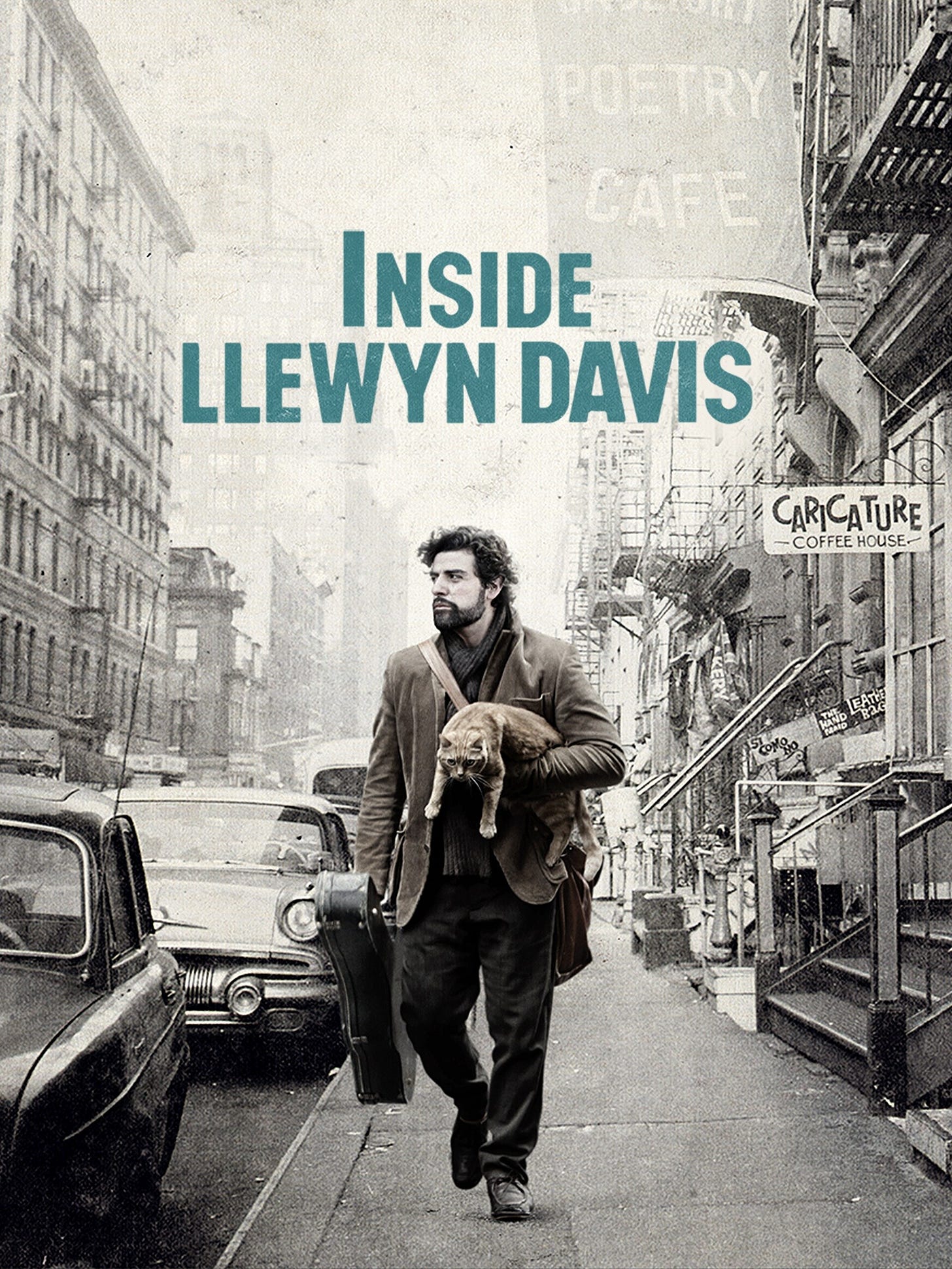A Complete Unknown
Degrees of Separation
The family dragged me out to see "A Complete Unknown" this weekend. I expected to hate it. I didn't.
For those of us who are one and two degrees away from the people and events depicted in the film – and there are a lot of us in my network – handing over the narrative to Hollywood is unsettling at best.
I wasn't born in 1965 and I've never met Dylan. But I've met Joan Baez, exchanged letters with Pete Seeger, opened for Arlo Guthrie (son of Woody), performed at Newport, and urinated next to Dave Van Ronk (for the record, we were both urinating – it wasn't some kind of weird assault).
I have good friends who are much more connected than me. My frequent musical partner, Reggie Harris, is one of many I know who had a real relationship with Pete; my old friend, Betsy Siggins, was Joan’s college roommate and a friend to Dylan (she’s currently working on a memoir); and I've had some good, long talks about music through the years with Elijah Wald, the excellent writer whose book is the credited source material for the film.
All of which is to say, the movie hits close to home.
My biggest concern, as I know it was for many fellow folkies, was the depiction of Pete Seeger. Rock history has long painted an ugly picture of Pete at Newport in 1965. For those who know nothing else about him, he's often been reduced to a folk tyrant who lost the war to rock.
As it turns out, Ed Norton's depiction of Seeger is, I think, the best thing about the film. He manages to capture not only Pete’s physical mannerisms but also his core decency and inner light. Credit to Norton's eyes.
Bigger credit to Wald's text. I haven't read the book yet, but reviews of "Dylan Goes Electric! Newport, Seeger, Dylan, and the Night That Split the Sixties," and everything I know about Elijah, suggest that the film's nuance and balance comes largely from him.
The inclusion, especially, of Seeger’s appearance in front of the House Un-American Activities Committee at the beginning of the film was both surprising and welcome. (For the uninitiated, Pete Seeger was simultaneously a nerd and one of our country’s greatest-ever badasses – in the words of Bruce Springsteen, “like your granddad, if your granddad could kick your ass.”)
People close to the events and places depicted in the film are bound to quibble with the details. Things are inevitably compressed and shuffled, people are compounded. Those in the business of storytelling, however, will understand and forgive. Real life isn't narrative.
It was the same deal when the Coen brothers' "Inside Llewyn Davis" – loosely based on Dave Van Ronk's memoir, "The Mayor of MacDougal Street," co-written with, once again, Elijah Wald – came out in 2013. I remember talking to someone at the time who was aghast that the movie version of The Gate of Horn Club had a bar in the back: "It was a coffeehouse!"
Pbbbbt.
What matters to me is what people take away. Most folks in my kids' generation – and in mine, for that matter – have never heard of Pete Seeger. Dylan is a myth. Do people leave the film with any deeper understanding of this particularly formative period in American culture?
On that front, I think the movie offers about as much as one can expect from Hollywood. My teens – who know a lot more about this history (not by choice!) than most of their peers – were left confused as to why Dylan's plugging-in was such a big deal. One said, "It didn't really sound that different – it was pretty folk-rock-y." The other wondered why the Newport crowd seemed happy to hear Johnny Cash's band play electric but were angry at Dylan for doing the same the following night. (For nitpickers, Cash actually played Newport in ‘64, not ‘65).
These are good questions which require answers the film can only hint at. To fully understand what went down at the Newport Folk Festival in 1965, you not only need to grasp the crowd's feeling of "ownership" over Dylan, but also the teenybopper commercialism of early ‘60s rock, the singularity of Johnny Cash within the context of country music’s broader conservatism, and all the ways in which Dylan affected the course of subsequent pop music history. To a kid raised on the (electric) poetic mysticism of late-stage Beatles, Dylan's plugged-in performance seems par for the course.
As for the rest of the cast, I thought Monica Barbaro did a fine job with a pretty impossible task. You can't imitate an inimitable voice, but she managed to capture some of Joan’s punk-ass fire.
Chalamet's performance as Dylan lacks depth, but it's not his fault. For an actor to inhabit a character, he needs to understand his subject's inner life and motivation. As the movie's title suggests, that simply isn't possible with Dylan. I think he is, and always has been, as unknowable to himself as to everyone else. (Check out his 2004 interview with Ed Bradley on "60 Minutes" and tell me if you come away with a different conclusion).
Dylan was ambitious, often callous, not infrequently cruel. He was also brilliant, diligent, and present to the muse (while drowning in almost unparalleled fame). Those truths are hard to reconcile, but they abound in art. We want our geniuses to be humans we can relate to. Often they're not.
I hope “A Complete Unknown” will be a jumping off place for folks to dig deeper. I hope a few kids will walk away wanting to hear more Dylan tunes and maybe get curious about why Woody Guthrie, Blind Lemon Jefferson, and others in the folk-blues canon influenced him so deeply. And I hope Hollywood decides that, if a story like this one can find an audience, maybe it's worth giving equal attention and reverence to some of the other earth-shakers of the era.
Stevie Wonder and Nina Simone next, please.







Thanks for this excellent review of a movie that somehow manages to capture the iconic feel of an iconic period and its characters. You hit the nail on so many points. Dylan is indeed unknowable and yet so very captivating even go red cruise of us who find him indulgent and wearying. His brilliance is unquestioned. I’d have loved to have had more of a view of his relationship with Phil Ochs , a contemporary who embodied more of what Seeger had in mind in passion for social change Alex is coming to watch but less of the commercial aspect that fit Dylan’s ambition. My other irritation was in the portrayal of Toshi Seeger who , in real life was less go eyed and silent in her vigorous support of Pete and his goals. Cest la vie. The movie is stunning.And so very well deserving of praise.
Great review, wasn’t gonna see film, but now think I will. Loose connection with that era, unrequited love for Maria Muldaur after seeing her and Jim Kweskin et al at great coffee house Le Hibou in Ottawa (long story I wrote about somewhere). Saw a young Joni Mitchell, Sonny Terry and Brownie McGhee, Howlin’ Wolf, all sorts of greats. Met Dave Van Ronk once, Dylan scowled at me once (another long story). I think after watching this film a good idea is to view Don’t Look Back, especially I guess for younger folks.